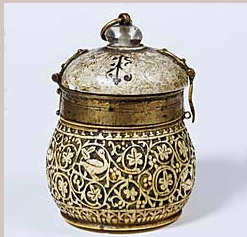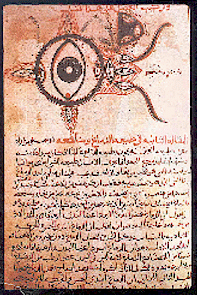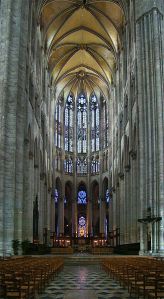At the beginning of this period the Fatimid rulers of Ifriqiyah (now known as Tunisia) expanded their realm into Egypt. In 969 they established a new capital near the existing town of Fustat. They called it al-Qahira, Victory. By the end of this period Qahira (or Cairo) was a vibrant and flourishing city. A millennium later, Cairo is still arguably the cultural centre of the muslim world.
Skilled craftspeople soon came to the new city. Lustreware, ceramics with a metallic glaze, was now made here. Producing it is a complicated process, so an entire industry shifted its base of production 2000km west from Basra to Cairo in this period.

Here is a lustreware bowl from the end of this period, now in the Metropolitan Museum of Art, New York.
The Fatimids quickly set about establishing a centre of learning. Al-Azhar mosque was built in 972. (Al-Azhar means ‘The Luminous’, one of the names used to describe the Prophet’s daughter Fatima.) Scholars were invited to base themselves there. By 975 it had a library and is now considered to be the oldest continually-operational university in the world. Philosophy, astronomy, law, logic and grammar were studied there. Some of these subjects were deemed heretical in the Abbasid capital of Baghdad, and so the scholars moved to the freer air of Cairo. At Al-Azhar they continued the line of learning that that had been inherited from the Greeks, Persians, Indians and further developed in the muslim world. In the following generation the founder of the scientific method, ibn al-Haytham, moved to al-Azhar from Basra in the footsteps of the lustreware makers. At the Luminous University he developed a new theory of the nature of light.
 Talking of luminosity, for me one of the outstanding artistic achievements of this period is the carved rock crystal ewers.
Talking of luminosity, for me one of the outstanding artistic achievements of this period is the carved rock crystal ewers.
This one made the journey from Egypt to King Roger in Sicily, to Italy (where it acquired the gold filigree lid) to the abbey of Saint-Denis in Paris. It is now in the Louvre Museum.
They are exquisite. Only a few survive. Perhaps only a few were made; after all, how many solid pieces of rock crystal of such clarity could be found?
The Fatimids were not only tolerant of ideas. They were accepting of the beliefs of other People of the Book, including the Coptic Christians who formed a large minority of the population of Egypt. Thanks to a cache of documents discovered in the store room of a Cairo synagogue, it is now known that there was an extensive trading network of Jewish merchants across the Mediterranean and through the Middle East. The Genizah (Hebrew for ‘storeroom’) documents tell us of a regulated world where people conducted their business affairs, paid their taxes, petitioned the administration in cases of injustice. The officials they petitioned may have been christian or muslim: all worked together in the ordered world so rapidly established during this caliphate.
The first caliph, al-Muizz, is credited with inspiring the invention of the fountain pen. He asked for a pen that would not stain his clothes with its ink, and it is said that a pen with a reservoir of ink was made (although none survive). Maybe he didn’t want to stain his beautiful silk garments.
This veil of linen and silk, was made in the year 983. It is now in the Metropolitan Museum of Art, New York.
With the exception of al-Hakim, the caliph who had ibn al-Haytham imprisoned, the Fatimid dynastywas open and tolerant. In the following century christian pilgrims were able to visit Jerusalem. Good relations were established with the christian kings of Sicily (who defeated client emirs of the Fatimid caliph to gain control of the island). When the shi’a Fatimids were defeated by the sunni Seljuk Turks, this window of opportunity came to an end and the light of learning moved elsewhere.







